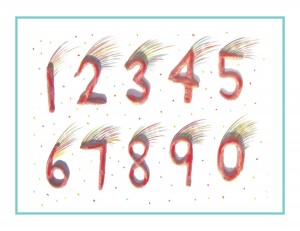Day 9
For one year, 365 days, this blog will address the Common Core Standards from the perspective of creating an alternate, ambient learning environment for math. Ambient is defined as “existing or present on all sides, an all-encompassing atmosphere.” And ambient music is defined as: “Quiet and relaxing with melodies that repeat many times.”
Why ambient? A math teaching style that’s whole and all encompassing, with themes that repeat many times through the years, is most likely to be effective and successful. Today’s blog will focus on Standard 3 in the Kindergarten Operations and Algebraic Thinking. Note that the Common Core Standards will appear in blue, followed by an ambient translation.
Operations and Algebraic Thinking K.OA
3. Decompose numbers less than or equal to 10 into pairs in more than one way, e.g., by using objects or drawings, and record each decomposition by a drawing or equation (e.g., 2 + 3 = 5 and 4 + 1 = 5).
Today’s venue is big and colorful, and can be set up in or out of doors. Three large (at least 36″) circles will be used, with the left and middle circles containing the decomposed numbers and the circle on the right containing the number. The circles can be formed in several ways: 1) traced on the ground, pavement, or low-pile carpet using a stick or chalk, 2) homemade hula hoop circles, or 3) rope circles.
These circles can be used for large-motor movement that’s applied to almost any basic skill up to third grade, like number and letter formation, 4 processes practice, form drawing from first grade on, and just plain fun and games! Here’s how to make them.
1) Traced Circles: Cut a piece of string to about 1/2 the diameter of the circle plus an inch or so (20″ for a 36″ circle). Tie one end to a pointed stick or pencil and place it where you want your circle’s center to be. Tie the other end to whatever you’re using and walk around with the chalk/stick on the floor/ground, tracing your perfectly round circle!
2) Hula Hoops: Buy a roll of 3/4″ flexible vinyl tubing (white, clear, or colored) and as many connectors as you need (one for each hoop) at any hardware store. Measure the correct length (the top of the circle should come up to the user’s waist), and cut the tubing with a clipper, mat knife, or saw. Place the two ends in boiling hot water for 20 seconds, then slide the connector into both ends until they meet. For more fun, insert pebbles or beans to make a “rainstick” sound. The hoops can also be twirled around the waist, jumped over, or rolled on a smooth surface with a stick.
3) Rope: Tie a knot in soft, thick, colorful rope and test the circle for size. Trim the ends of the knot. Or for a more permanent circle, overlap the two ends at least 3″ and tape it with the same or a contrasting color.
Now for the math. Place the three circles on the ground or floor and represent the numbers in any of the following ways:
1) Stand in the right hand circle and jump or clap 5 times while counting, then hold up 5 fingers. Have the child(ren) stand in the far left circle and jump or clap a lesser number while counting, then hold up that number of fingers. Have the same child (or another) jump or clap the remaining number in the middle circle. Fully demonstrate this first, of course.
2) Make some (about 20) “flags” with sticks or dowels: cut colorful pieces of 9 x 12 felt in half diagonally and staple, glue, or sew them to the tops of the sticks/dowels. Note that any hands-on materials like these can be used repeatedly, and half the fun is making them, so have the child(ren) help as much as they can! Follow the same process with the flags, counting as you stick them into the ground. (This would need to be done outdoors on grass.)
3) Use any other (preferably large-ish) objects to do the same activity. Make it fun, and stop to play some games in between, like tag, hide and seek, or duck-duck-goose.
For the drawing on paper part, trace sets of three circles onto a large piece of cardboard or foam core (these will be used again and again) with markers or crayons. I like to use glasses or small plates as tracing templates. Have a pile of pennies or other small, flat objects like buttons on hand. Do the same as above, placing a number of objects in the right-hand circle and having the child(ren) fill the other two with the correct amounts. Place a piece of plain paper over all three circles, lightly taping down the corners, and have the children make “rubbings” with crayons, circling the groups of numbers when done.
BTW, you can find pieces of foam core and mat board at craft or frame stores for free or very little cost. You may want to save these finished drawings in a folder and bind them into a little book at the end of the year. Remember, knowledge ensues in an environment dedicated to imaginative, creative knowing, where student and teacher alike surrender to the ensuing of that knowledge as a worthy goal. More Kindergarten tomorrow!












